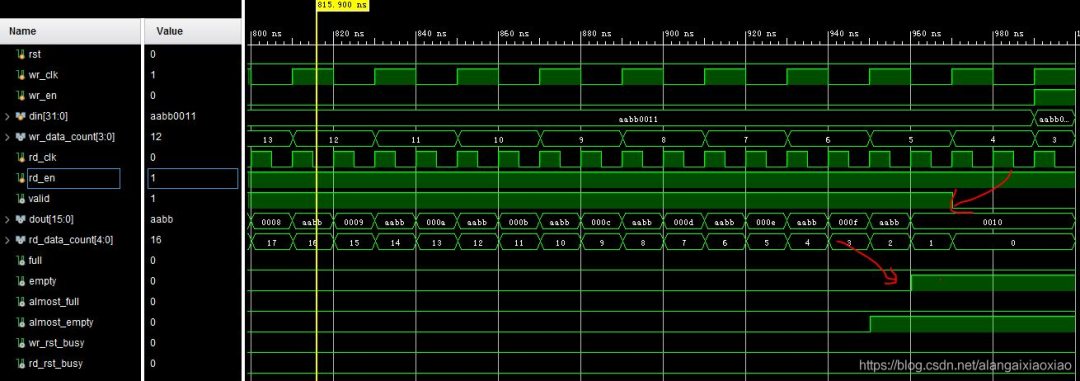FIFO的使用非常廣泛,一般用于不同時鐘域之間的數(shù)據(jù)傳輸,或者用于不同數(shù)據(jù)寬度之間的數(shù)據(jù)匹配。在實際的工程應(yīng)用,可以根據(jù)需要自己寫FIFO。不考慮資源的情況下,也可以使用Xilinx提供的IP核來完成。
接口類型選擇Native,SOC芯片上也可以根據(jù)需要選擇AXI接口。

選擇存儲器類型:可以用塊RAM、分布式RAM,移位寄存器和內(nèi)嵌FIFO來實現(xiàn)FIFO。這里主要是block RAM和distribute RAM之間的區(qū)別。簡而言之,block RAM是FPGA中定制的ram資源,而distribute RAM則是由LUT構(gòu)成的RAM資源。由此區(qū)別表明,當(dāng)FIFO較大時應(yīng)選擇block RAM,當(dāng)FIFO較小時,選擇distribute RAM.另外一個很重要的就是block RAM支持讀寫不同寬度,而distribute不支持。在這里為了更全面的了解FIFO,選擇block RAM以擁有非對稱方向速率的特性,內(nèi)嵌FIFO(Builtin FIFO)在5以上的FPGA芯片中才存在。
時鐘:讀寫操作是否在相同的時鐘域中完成。如果是,可以選擇Common clock,否則,選擇Independent clcoks。
讀模式有兩種選擇,一般選擇標(biāo)準(zhǔn)模式,F(xiàn)irst-Word Fall-Fhrough模式為首字預(yù)現(xiàn),F(xiàn)WFT是指在不影響FIFO讀操作的情況下,提前查看下一個數(shù)據(jù)的能力。即FIFO中不為空,有可用的數(shù)據(jù)時,F(xiàn)IFO中的第一個數(shù)據(jù)自動出現(xiàn)在輸出總線DOUT上。
Synchronization Stage:穿過交叉時鐘域的同步狀態(tài)(寄存器)數(shù)量,默認(rèn)即可。

data port parameters處,有actual write depth和actual read depth,他們都比我們設(shè)置的要小,在實際的工程應(yīng)用中,F(xiàn)IFO深度確實要比預(yù)設(shè)的小1,即當(dāng)寫入了Write Width-1個數(shù)據(jù)之后,F(xiàn)IFO的滿信號full會拉高,這個時候如果還要寫入數(shù)據(jù),則寫入的數(shù)據(jù)丟失。同理,讀出Read Width-1個數(shù)據(jù)后,F(xiàn)IFO的空信號empty會拉高,此時讀出信號無效。如下:

該FIFO數(shù)據(jù)深度為16,從aabb0002到aabb0011共寫入16個數(shù)據(jù),當(dāng)寫入到第15個時,F(xiàn)ULL信號拉高,數(shù)據(jù)不能被有效的寫入,從讀狀態(tài)可以看出。當(dāng)讀寫數(shù)據(jù)位寬不匹配時,寫入的位寬大于讀出的數(shù)據(jù)位寬,則先從高位開始讀;當(dāng)寫入的數(shù)據(jù)位寬小于讀出時,先寫入的數(shù)據(jù)在讀數(shù)據(jù)的高位,如下:

關(guān)于FIFO復(fù)位,Xilinx FIFO默認(rèn)為高電平復(fù)位,在Initialization 中可以設(shè)置復(fù)位信號到來之后,full、almost full、prog full等信號的復(fù)位值為0,或者為1。可以設(shè)置讀寫同步復(fù)位,或者異步復(fù)位。fifo的復(fù)位需要一段時間,期間wr_rst_busy和rd_rst_busy信號為高電平,此時應(yīng)禁止讀寫FIFO,否則會造成數(shù)據(jù)丟失。
關(guān)于讀寫計數(shù),讀計數(shù)是和讀時鐘同步的,寫計數(shù)是和寫時鐘同步的。讀計數(shù)是以讀數(shù)據(jù)寬度為單位,fifo中存在的數(shù)據(jù)個數(shù);寫計數(shù)是以寫數(shù)據(jù)寬度為單位,fifo中存在的數(shù)據(jù)個數(shù),這兩個值的結(jié)果,簡單理解就是fifo內(nèi)部控制器讀寫地址的差,由于fifo讀寫時鐘可能異步,讀寫時鐘頻率不同,導(dǎo)致計算讀寫計數(shù)值時存在延遲,并不完全和讀寫操作同步。

讀寫計數(shù)仿真結(jié)果如下:

關(guān)于讀寫使能,寫使能wr_en為高時,數(shù)據(jù)立即被寫入到fifo中,讀使能為高時,下一個時鐘周期,有效數(shù)據(jù)才會出現(xiàn)在數(shù)據(jù)總線dout上。
一段簡單的仿真如下:
`timescale 1ns / 1ps
module tb_fifo_16x256(
);
reg rst;
reg wr_clk;
reg rd_clk;
reg [31:0] din;
reg wr_en;
reg rd_en;
wire [15:0] dout;
wire full;
wire empty;
wire valid;
wire almost_full;
wire almost_empty;
wire [4:0] rd_data_count;
wire [3:0] wr_data_count;
wire wr_rst_busy;
wire rd_rst_busy;
always #10 wr_clk <= ~wr_clk;
always #5 rd_clk <= ~rd_clk;
initial begin
rst <= 1;
wr_clk <= 0;
rd_clk <= 1;
din <= 32'haabb0001 ;
wr_en <= 0;
rd_en <= 0;
#20;
rst <= 0;
#300;
//======================================================empty
repeat(16) @(posedge wr_clk)
begin
din <= din + 1;
wr_en <= 1;
end
repeat(1) @(posedge wr_clk) wr_en <= 0;
repeat(32) @(posedge rd_clk)
begin
rd_en <= 1;
end
repeat(1) @(posedge rd_clk) rd_en <= 0;
//=======================================================full
repeat(16) @(posedge wr_clk)
begin
din <= din + 1;
wr_en <= 1;
end
repeat(1) @(posedge wr_clk) wr_en <= 0;
end
initial begin
#900;
repeat(32) @(posedge rd_clk)
begin
rd_en <= 1;
end
repeat(1) @(posedge rd_clk) rd_en <= 0;
end
fifo_16x256 fifo_16x256_inst (
.rst(rst), // input wire rst
.wr_clk(wr_clk), // input wire wr_clk
.rd_clk(rd_clk), // input wire rd_clk
.din(din), // input wire [31 : 0] din
.wr_en(wr_en), // input wire wr_en
.rd_en(rd_en), // input wire rd_en
.dout(dout), // output wire [15 : 0] dout
.full(full), // output wire full
.almost_full(almost_full), // output wire almost_full
.empty(empty), // output wire empty
.almost_empty(almost_empty), // output wire almost_empty
.valid(valid), // output wire valid
.rd_data_count(rd_data_count), // output wire [8 : 0] rd_data_count
.wr_data_count(wr_data_count), // output wire [7 : 0] wr_data_count
.wr_rst_busy(wr_rst_busy), // output wire wr_rst_busy
.rd_rst_busy(rd_rst_busy) // output wire rd_rst_busy
);
endmodule
更多信息可以來這里獲取==>>電子技術(shù)應(yīng)用-AET<<


